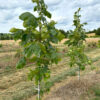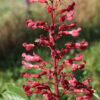For August, we turn to our largest native cherry, Prunus serotina (seh-roh-TEE-nuh), the wild black cherry. This cherry’s native habitat stretches across a broad swath of eastern North America, from Minnesota and Nova Scotia south to central Florida and east Texas, with pockets of subspecies inhabiting the higher elevations from the desert southwest to central México and Guatemala. It is a fast-growing plant, a colonizer of fields and disturbed ground, a valuable food source for wildlife and a prized timber tree. It is the last Prunus species to flower in the spring in most locations (serotina means ‘late’.)
Prunus serotina is typically quick to establish; it prefers sunny situations, neutral to acidic soils, and average moisture and is intolerant of standing water. Pyramidal in youth, it develops an irregular open crown with age, maturing under good conditions to a height of 15-25 m (50-80 ft), occasionally to 30 m (100 ft). The crown can be relatively narrow or as broad as the height depending on competition from other trees. The branchlets are thin like that of Salix (willow) and often droop slightly under the weight of flowers or fruit. Unlike most cherries, the simple, lightly-toothed, oval leaves are an attractive dark, glossy green. Autumn color typically is yellow to orange-yellow. The bark for the first decade of life and on younger branches is a thin medium-brown with paler horizontal lenticels, much like Betula (birch) and peels away in horizontal strips if broken. As the tree matures, the bark becomes a chunky dark grey or black. Black cherry typically flowers in mid-spring in Virginia, shortly after leaf emergence. The drooping 10-15 cm (4-6-inch) racemes usually bear thirty or more small white flowers and are typically numerous enough to give a hazy greenish-white appearance to the tree for a few days. The resulting fruits are very small, typically 5-10 mm (¼ to ⅜ inch) in diameter and ripen from dark red to a rich purple-black as autumn progresses.
[Article continues below photos.]
Like many Prunus, P. serotina is an important food source for wildlife. The fruits and enjoyed by many songbird species, squirrels, and bears; while the foliage, bark, and young twigs are browsed by white-tailed deer and rabbits. The foliage is host to several species of moths and butterflies, including, unfortunately, the eastern tent caterpillar (Malacosoma americanum), a moth larva which builds silky tents in branch crotches in spring and can temporarily defoliate and entire tree. Like most members of the cherry family, the leaves, crushed seeds (‘pits’), and bark contain cyanogenic glycosides which break down through enzymatic oxidation to cyanides, giving crushed foliage a distinctive bitter almond scent. While most native wildlife has evolved to tolerate these compounds, livestock and humans are both susceptible to poisoning if consumed in significant quantities. The fruit flesh, while containing cyanide precursors, lack the enzymes to oxidize them and thus are safe for virtually all animals, including humans. The fruits have long been used for jellies and jams and as a flavoring for alcohol (hence the old common name of ‘rum cherry’). The inner bark was also brewed in very light concentrations by Native Americans as a cold and cough remedy.
Perhaps Prunus serotina’s greatest commercial value is as a timber tree. The wood varies from pale yellow-white in the outer layers to a thick heartwood of rich, reddish-brown. This heartwood is prized for furniture, floors, and many other situations where finished lumber is a focal point.
Black cherry was one of the first trees from the New World planted in English gardens, with documentation as far back as 1629. It was later introduced as an ornamental in South America; in both instances it has become somewhat invasive. In the domestic landscape, black cherry is a versatile addition. It can be maintained at a smaller height due to its tolerance of hard pruning; it provides a dappled shade which allows many plants to grow under its canopy, and, as noted, is an attractor of wildlife. Besides tent caterpillars, Prunus serotina is — like most members of the genus — somewhat brittle and occasionally susceptible to canker and other diseases. The wood, however, is quite slow to decay from rot or fungus. In short, it is a common but little-used tree that can be a great addition to the native garden.







